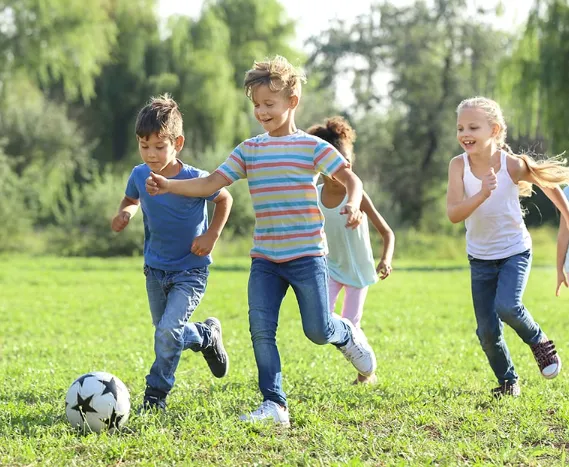As parents and coaches, we all want the best for our young soccer players—those moments when they glide past defenders with ease, make perfect feints, and play with confidence. But reaching that level of play requires more than just practice; it demands the right approach to training, guided by a solid understanding of how the brain learns and adapts.
It’s easy to focus on drills and game-like scenarios, but many overlook the critical role neuroplasticity—the brain’s ability to change and adapt—plays in soccer development. Understanding this process can be a game-changer, helping players develop skills more effectively and enjoy the game more fully.
The Power of Neuroplasticity in Soccer Development
At its core, neuroplasticity refers to the brain’s ability to reorganize itself by forming new neural connections. This process is how we learn and master new skills, and it’s especially important in sports like soccer.
In soccer, neuroplasticity is at work every time a player practices—whether through structured drills, free play, or casual practice at home. With each repetition, the brain strengthens the neural pathways needed to perform specific movements. The more a player practices a move, the more natural and automatic it becomes. But variation is just as important. Trying new moves or different scenarios encourages the brain to adapt creatively, making the player more versatile and prepared for game situations.
Free Play vs. Structured Training: Finding the Right Balance
There’s a long-standing debate about the effectiveness of street soccer versus structured training. It’s often believed that street soccer, with its freedom and spontaneity, is the key to developing top players. While free play has its benefits, it’s important to understand that players like Ronaldinho didn’t rely solely on street soccer. They also refined their skills in formal training environments, under the guidance of experienced coaches.
Structured training offers something that free play can’t: focused repetition and technical development. Free play fosters creativity, but structured sessions build the foundational skills needed for success in competitive soccer. Combining the two—freedom and structure—creates a well-rounded player capable of both creative expression and solid technique.
Why Your Child Might Not Be “Getting It” Yet
It’s common to get frustrated when a child doesn’t execute a new skill in a game right away. For example, after practicing a move like the Cruyff turn, they may still struggle to use it in a match. The key here is patience. Even if the move isn’t perfect right away, the brain is still absorbing the repetition and strengthening the neural pathways needed to execute it smoothly in the future.
When kids practice, they aren’t just learning how to perform a specific move—they are training their brains. Over time, those movements will start to come naturally during real-game situations. The brain is constantly adapting, even if the improvement isn’t immediately visible.
Structured Training Still Matters, Even with Game-Like Play
Some argue that game-like training scenarios are enough for players to learn new moves. While it’s true that children learn in game-like settings, structured drills still play a critical role in developing technical skills. Each drill isn’t just about learning one move; it’s about enhancing the brain’s ability to react and adapt to various game situations.
This is where a balanced approach comes in. Every time a child touches the ball—whether in a drill or during a game—they are reinforcing their brain’s capacity to perform well under pressure. Combining both methods accelerates development, ensuring players have both the technical skills and the decision-making ability needed in real games.
The Myth of “Monkey-See, Monkey-Do”
Many parents and coaches feel that they need to be perfect players themselves to teach their children. The reality is, you don’t need to be a pro to help your child improve. What matters most is consistency, patience, and understanding how children learn.
Teaching soccer isn’t about flawless execution; it’s about showing basic movements, providing clear instructions, and giving children the chance to repeat those movements themselves. It’s their practice, not your perfection, that drives improvement.
Finding the Right Balance: Drills vs. Games
There’s no shortage of studies suggesting that game-like training is superior to drills. While this is true to an extent, it doesn’t tell the whole story. Unopposed drills provide critical repetition and technical focus, while game scenarios teach players to think on their feet and make decisions under pressure.
What works best is a blend of both. Drills give players the technical foundation they need, while games challenge them to apply what they’ve learned in dynamic situations. Together, these two elements accelerate learning and development.
Variation is Key to Growth
Soccer is not about flawless execution—it’s about adaptability. Players need to face a variety of situations during training to develop the flexibility to handle anything the game throws at them. This is where variation becomes the MVP of training.
Whether a player is performing a move they’ve mastered or improvising on the fly, variation in training helps them become adaptable problem-solvers on the field. Encouraging different drills and scenarios in practice prepares players to think quickly and react to new challenges.
Teaching “Good Enough”
It’s tempting to think that every skill needs to be performed perfectly, but soccer isn’t about perfection—it’s about progress. The drag-back turn, for example, may not look flawless the first time it’s used in a game, but it can still be effective.
Training isn’t about perfection—it’s about giving kids the tools to improve, make mistakes, and learn from them. By teaching “good enough,” players are given the freedom to grow at their own pace and develop confidence.
Final Thoughts
Ultimately, the goal of soccer training is not just to create skilled players, but to nurture their love for the game and foster continuous growth. By understanding neuroplasticity and how the brain learns, we can adopt training strategies that provide the right balance of repetition, variation, and creativity. With patience and consistent practice, players will not only develop their technical skills but also build the confidence and adaptability needed to succeed on the field.
















